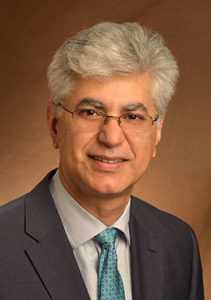The National Highway Traffic Safety Administration (NHTSA) has estimated that almost 43,000 people died in motor vehicle crashes in the US in 2021.

Asad Khattak
This shocking figure, a fifteen-year record, is part of a tragic trend that Beaman Professor Asad Khattak has been fighting to reverse.
“UT is a great place to conduct cutting-edge traffic safety research,” Khattak said. “We have the Center for Transportation Research (CTR), access to new transportation technologies, facilities such as the driving simulator, collaborations with personnel at Oak Ridge National Lab (ORNL), and access to ORNL supercomputers.”
Khattak also praised UT’s excellent research ecosystem, from undergraduate students to faculty members in multiple departments.
“Transportation safety is a multidisciplinary field,” said Khattak. “It includes planning; public health; civil, mechanical, and industrial engineering; logistics; and science fields such as psychology, data science, and computer science.”
To encourage such broad collaboration, the US Department of Transportation (DoT) funds institutions studying pressing issues in transportation safety. One such group, the Collaborative Sciences Center for Road Safety (CSCRS) at the University of North Carolina (UNC), is celebrating its sixth anniversary this year.
CSCRS was initially funded in 2016 through a DoT grant competition and currently includes nineteen principal researchers from UT, UNC, Duke University, Florida Atlantic University, and the University of California, Berkeley. Since its inception, the center has funded more than 40 studies, devoting more than $33.8 million to transportation safety research and education.
Khattak is joined at CSCRS by fellow CEE Professor Chris Cherry; Associate Professor Subhadeep Chakraborty from the Department of Mechanical, Aerospace, and Biomedical Engineering; and CTR Research Director Jerry Everett.
Together, these four UT researchers have headed almost a third of CSCRS’ research projects.
Each study furthers CSCRS’ goal of developing and implementing the “Safe System Approach,” a model which incorporates the complex factors of the current national transportation network while investigating how to eliminate traffic fatalities and injuries.
“The development and adoption of the Safe System Approach by the US DoT is the most significant impact of CSCRS so far,” said Khattak. “Our work has advanced life-saving technology in vehicles and roadway infrastructure.”
For example, Khattak has collaborated on three projects related to motorcyclist injuries.
“We’ve investigated the severity of motorcyclist injuries across Tennessee and identified ‘hotspot’ locations where injuries are the worst and most frequent,” said Khattak. “Then we prepare and apply evidence-based countermeasures that can reduce rider-related and environmental risk factors, helping to prevent motorcyclist injuries in the future.”
“These studies really accelerate the transition from research to planning and policy implementation,” Khattak added.
In other projects, Khattak is focused on reducing human errors behind the wheel using Advanced Driver Assistance Systems (ADAS), such as blind spot detection and adaptive cruise control, and Automated Driving Systems (ADS), such as fully driverless vehicles.
“Human errors contribute very substantially to crashes,” Khattak said. “By monitoring driver biometrics like heart rate and eye movement, we can detect distraction and impairment early, enhancing the role of ADAS and ADS.”
To mark its sixth anniversary, CSCRS has released a video explaining the Safe System Approach and covering some of the center’s important impacts to date.
Far from resting on their laurels, the researchers eagerly look forward to continuing to enhance transportation safety.
“The main goal for the next six years of CSCRS is to make real progress toward eliminating traffic deaths in the US,” said Khattak. “We plan to apply the Safe Systems Approach and artificial intelligence methods to solve complex safety problems.”
